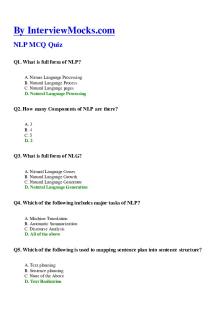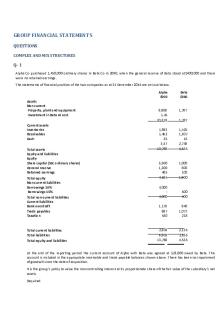MCQ 1000% Complex Variable Functions Questions and Answers - Sanfoundry PDF

| Title | MCQ 1000% Complex Variable Functions Questions and Answers - Sanfoundry |
|---|---|
| Author | Anonymous User |
| Course | Direct and indirect taxation paper V |
| Institution | University of Mumbai |
| Pages | 7 |
| File Size | 242.1 KB |
| File Type | |
| Total Downloads | 51 |
| Total Views | 139 |
Summary
Pdf for becom yeah not only this Mumy dantri h phle kha fir kheliyo, fir kheliyo aur guysss
Khana abhi tk nhi bana 🥲Dil ka dariya .....
Behhhh hii gaayaaaa ......
Isssshqq ibbaadatt bann hi gyaa.....
Description
Complex Analysis Questions and Answers – Functions of a Complex Variable « Prev
Next »
This set of Complex Analysis Multiple Choice Questions & Answers (MCQs) focuses on “Functions of a Complex Variable”. 1. Find the domain of the function dened by f(z)=z/(z+z) . a) Im(z)≠0 b) Re(z)≠0 c) Im(z)=0 d) Re(z)=0 View Answer Answer: b Explanation: Write z=x+iy ⇒ f(x+iy)=(x+iy)/(x+iy+x-iy)=(x+iy)/2x =1/2+iy/2x ⇒ x≠0 ⇒ Re(z)≠0 . advertisement
b) (r-1/r)cosθ+i(r+1/r)sinθ c) (r+1/r)sinθ+i(r-1/r)cosθ d) (r+1/r)sinθ+i(r-1/r)cosθ View Answer Answer: a Explanation: Write z=r(cosθ+isinθ), therefore, f(z)=z+1/z=r(cosθ+isinθ)+1/[r(cosθ+isinθ)] iθ -iθ =re +(1/r)e =r(cosθ+isinθ)+1/r(cosθ-isinθ)=(r+1/r)cosθ+i(r-1/r)sinθ. 3. For the function f(z)=zi, what is the value of |f(ω)|+Arg f(ω), ω being the cube root of unity with Im(ω)>0? a) e-2π/3 b) e2π/3 -2π/3 c) e +2π/3 -2π/3
d) e
-2π/3
View Answer Answer: a Explanation: Let y=zi ⇒ ln y=iln z=i(ln |z|+iarg z)=iln |z|-arg z ⇒ y=eiln |z|/earg z ⇒ |y|=earg z and Arg y=ln |z| ⇒ |f(ω)|+Arg f(ω)=e-2π/3 +0=e-2π/3 . advertisement
4. Let f(z)=(z2–z–1)7. If α2 +α+1=0 and Im(α)>0, then nd f(α). a) 128α
d) -128α2 View Answer Answer: c 2
7
Explanation: Note that α=ω. Therefore, f(α)=f(ω)=(ω –ω–1) =(ω2 +ω2 )7 =(2ω2 )7 =27 ω14 =128ω2 =128α2 .
5. For all complex numbers z satisfying Im(z)≠0, if f(z)=z2+z+1 is a real valued function, then nd its range. a) (-∞, -1] b) (-∞, 1/3) c) (-∞, 1/2] d) (-∞, 3/4) View Answer Answer: d Explanation: Let y=f(z). then z2 +z+1=y has imaginary roots (∵Im(z)≠0) ⇒ D...
Similar Free PDFs

Nlp questions and answers mcq
- 6 Pages

Sanfoundry MCQ QUZI
- 57 Pages

Complex Variable By Schaum Series.pdf
- 385 Pages
Popular Institutions
- Tinajero National High School - Annex
- Politeknik Caltex Riau
- Yokohama City University
- SGT University
- University of Al-Qadisiyah
- Divine Word College of Vigan
- Techniek College Rotterdam
- Universidade de Santiago
- Universiti Teknologi MARA Cawangan Johor Kampus Pasir Gudang
- Poltekkes Kemenkes Yogyakarta
- Baguio City National High School
- Colegio san marcos
- preparatoria uno
- Centro de Bachillerato Tecnológico Industrial y de Servicios No. 107
- Dalian Maritime University
- Quang Trung Secondary School
- Colegio Tecnológico en Informática
- Corporación Regional de Educación Superior
- Grupo CEDVA
- Dar Al Uloom University
- Centro de Estudios Preuniversitarios de la Universidad Nacional de Ingeniería
- 上智大学
- Aakash International School, Nuna Majara
- San Felipe Neri Catholic School
- Kang Chiao International School - New Taipei City
- Misamis Occidental National High School
- Institución Educativa Escuela Normal Juan Ladrilleros
- Kolehiyo ng Pantukan
- Batanes State College
- Instituto Continental
- Sekolah Menengah Kejuruan Kesehatan Kaltara (Tarakan)
- Colegio de La Inmaculada Concepcion - Cebu












